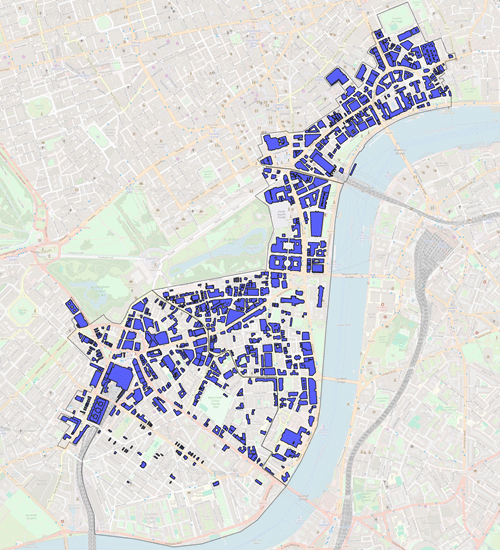£1bn low carbon heating infrastructure project unveiled in Westminster
Iconic London buildings in the heart of the capital to be heated by new low carbon heat network, expected to create 500 jobs and save 75,000 tonnes of CO2 every year.
Just days after the UK Government revealed an Autumn Budget that included significant infrastructure investment plans, a new £1bn low-carbon infrastructure project has been launched in Westminster, signifying a major step towards driving investment and creating well-paid, secure jobs.
Unveiled today, this large new heat network in Westminster will become one of the UK’s first ‘heat network zones’ – places where heat networks are the cheapest and best way to decarbonise compared to each building having its own air source heat pump. On average, heat networks are 40% cheaper for customers than building level heat pumps.
The heat network will supply low carbon heating, sourced from within the local area. The heat will need to come from innovative sources such as the London Underground, the Thames, and the sewer network. It might even be brought down the river on barges.
One of the core benefits of heat networks, is the ability to harness waste heat from within the local area and make use of it. This makes them low carbon, efficient and resilient, not relying on imported fuel.
Heat will then be distributed via a network of underground, insulated pipes filled with hot water. The zone will stretch from around Victoria Station, up to Temple Underground Station near the Strand, bounded by St James’ Park.
Over time, this significant new investment is expected to save 75,000 tonnes of CO2 every year, (equivalent to removing 40,000 cars from the road), create 500 jobs, improve local air quality by reducing nitrogen oxides emissions by 99%, and create 100 opportunities for UK businesses.
The South Westminster Area Network (SWAN) was brought to life by the Department for Energy Security and Net Zero, and Westminster City Council. To deliver the network, they have brought in the SWAN Partnership, a joint venture between Hemiko and Vital Energi, two of the leading heat networks developers in the UK, who were appointed last month. London Heritage Quarter and AECOM have also been key partners, supporting the network’s growth.
The SWAN Partnership will be funding, building and operating the heat network. They plan to invest £100m within 3 years, £500m within 10 years, and £1bn by 2050 into what will become one of the UK’s biggest heat networks.
SWAN reflects a currently unparalleled scale of ambition for growth and investment into heat networks, but it is something that the government wants to replicate in zones across the country.
By 2050, every major town and city is expected to need district heat networks, requiring over £100bn of private investment and 290k new jobs in total.
It is not yet known who will join up to this heat network, but Project SWAN could serve landmark buildings like the Houses of Parliament and the National Gallery, alongside buildings owned by Westminster City Council and the Government.
“Taking waste heat from the River Thames and London Underground to heat such iconic places as the Houses of Parliament and the National Gallery is a really exciting example of what lies ahead on our journey to low-cost, low-carbon heating. This project will help support hundreds of jobs and make bold new strides towards boosting our energy security, as one of seven heat network zones we’re backing with over £5million funding.”
“Heat networks are the most cost-effective way to decarbonise our densely populated cities. The Government’s heat network zoning regulations, introduced last year as part of the Energy Act, have now created the right market conditions for private sector investment. By combining Hemiko’s investment capabilities with Vital Energi’s comprehensive expertise in designing, building, operating and owning energy infrastructure, the SWAN Partnership will deliver the first zonal scale heat network and demonstrate a model that other towns and cities will seek to replicate.” Nick Gosling – Chief Strategy Officer of Vital Energi
Businesses are being encouraged to register their interest in joining the network, by emailing SWAN@hemiko.com. First movers are needed to unlock this least cost decarbonisation pathway and the jobs that come with it, for the benefit of everyone in Westminster. The more who join up, the cheaper it is for everyone.
From start to finish, it took just 4 months from launching the competitive process to signing the contract for SWAN and beginning the development work, five times faster than most procurement exercises run to date.
This new procurement approach for heat networks is expected to speed up the delivery of heat networks, to decarbonise the UK faster, and create a more investable heat networks market. This model, and variations of it, is expected to be replicated by at least 7 projects across the country within the next year alone, with more thereafter.
Construction of SWAN is due to start in 2026.
“It is fantastic to see that the South Westminster Area Network (SWAN) has taken this critical step forward. The council has been actively supporting the Government through the early stages of this pioneering network and will now take on a principal role to ensure that the project delivers the best outcomes for our residents and businesses. We know that the gas used to heat and power buildings is one of the biggest contributors to both carbon emissions and air pollution in Westminster. However, these new low-carbon district heat networks will tap into local waste heat sources, delivering clean and affordable energy to those who need it most. The SWAN project will be a crucial piece of our net zero carbon journey in Westminster, leading the way for others and showing what a positive clean energy future could look like.”

